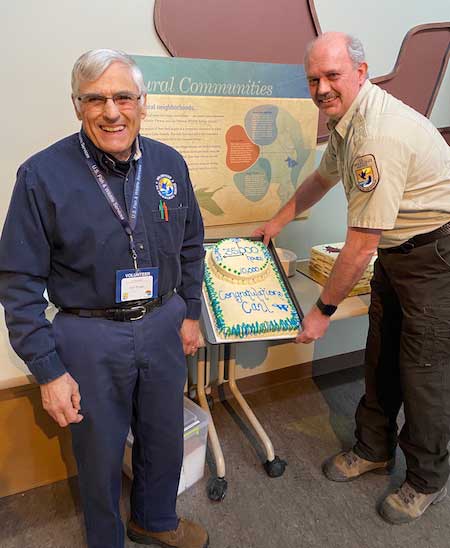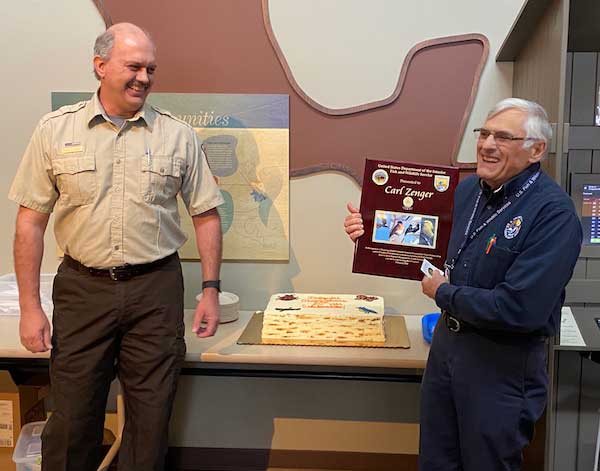Wildlife Refuge honors volunteer for reaching 35,000 hours of service
BASOM – A volunteer who has donated 35,000 hours at the Iroquois National Wildlife Refuge was honored on Saturday.
Carl Zenger began his volunteer service at Wildlife Refuge in 1997. He created an extensive cavity bird nesting program, helped re-establish a rapidly declining purple martin population, managed habitat, created opportunities for children, and built more nest boxes, bat, bird, and butterfly houses than anyone could count, refuge leaders said.
Zenger was joined by his wife Phyllis at the refuge on Saturday. Refuge Manager Tom Roster presented Zenger with a plaque and a 35,000-hour volunteer pin in front of the 65 visitors, Friends Board Members, Fish and Wildlife Service staff, NYS DEC staff, partners, and other volunteers.
Zenger has given about an average of 30 hours a week in volunteer service to the refuge since 1997. He is retired from a 42-year career as an engineer and supervisor at General Motors.

Carl Zenger has been nearly a full-time presence at the refuge since 1997, and has been instrumental in many projects. He is shown with Tom Roster, refuge manager, during a celebration in Zenger’s honor.
In his tenure at Iroquois NWR, Zenger spearheaded the restoration of what was once a tiny purple martin colony in 2001 into an impressive martin program with over 180 cavities at six locations today. In 2019, these cavities fledged 702 purple martins, which is an increase of 75 percent over the last 9 years.
Additionally, Zenger has headed the cavity nesting program since he learned the ropes. He designed a unique winch system for American kestrel boxes ensuring weekly checks can be safely accomplished. And through this program, Carl has banded and taught others how to age, sex, and band eastern bluebirds, tree swallows, purple martins, great-crested flycatchers, eastern screech owls, American kestrels, and prothonotary warblers. His team of volunteers banded 1,307 birds in 2019 with 99 percent of them fledging.
Zenger has taken students, children, volunteers, and the public under his wing. He has exposed these groups to the refuge, educated them about refuge programs, and has been known to let them hold a hatchling or two. He has been instrumental in a University of Buffalo study on nest parasites of purple martins, assisting the PhD candidate in organization and implementation of data collection at Iroquois NWR.
Every year, the Youth Conservation Corps students rave about working with Zenger on refuge banding projects, stating it was their favorite part of the summer. He helps with public outreach through special events and interpretive programming, and has even developed an educational program called Take-a-Kid-Along, allowing children to participate in and learn in a one-on-one situation about bird banding, bird identification, and marsh habitat exploration. It’s ideas and work such as these that help promote the refuge to not just younger audiences, but to all generations.
Since the day Zenger walked through the door, this energetic man has done anything refuge staff have asked of him from litter pick up to carpentry, habitat work, painting, and mowing, refuge leader said.
Along with the help of other volunteers, he has built 200-300 different habitat houses each year for the refuge’s annual Spring Into Nature festival. He even helps the children (and sometimes adults) build the houses to take home. Since becoming a certified tractor operator, he has personally mowed approximately 3,800 acres over the years in order to maintain habitat for ground nesting birds, pollinators, mammals and native plant species.
Additionally, he obtained his backhoe and tracked dozer operator certificates enabling him to assist with numerous habitat management projects including, floodplain restoration via dike removal, trail development, private lands habitat restoration projects, and water control structure installation.








































































